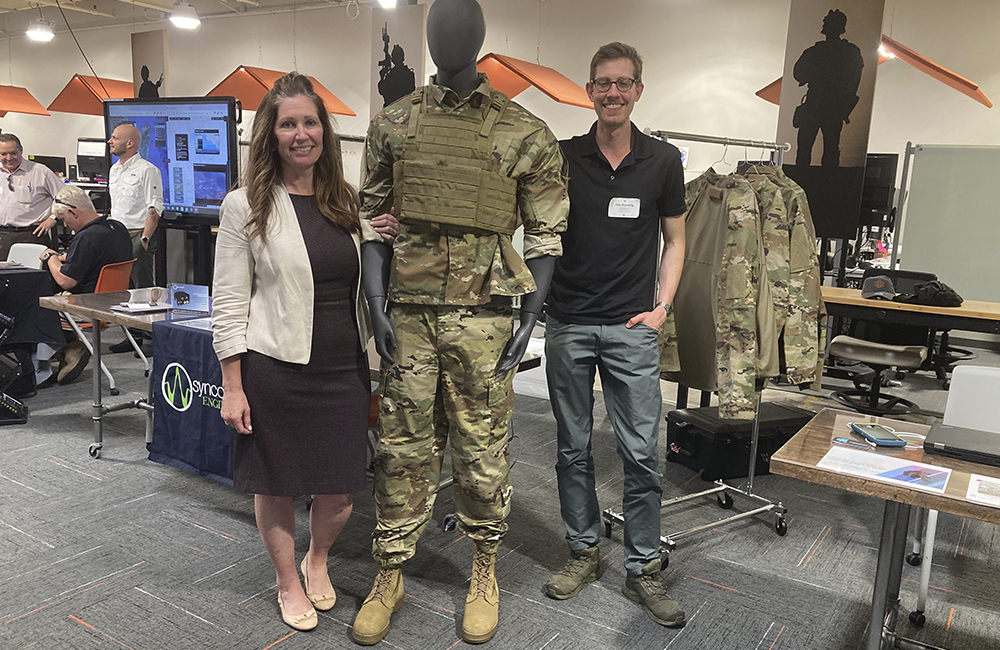SOFWERX Rapidly Develops Tech Prototypes for SOCOM Mission Needs
A nonprofit organization brings small businesses into the defense contracting fold.

A Tampa, Florida, nonprofit serves as a catalyst for small businesses to connect with U.S. Special Operations Command (USSOCOM).
That organization is SOFWERX, created in 2015 under an agreement between DEFENSEWERX and SOCOM. It rapidly develops prototypes to solve immediate problems and challenges SOCOM experiences in theater, such as a software-infused shirt that detects wounds and alerts medical personnel or a mobile IT system for SOCOM to communicate securely with international partners and foreign governments.
“It runs the gamut from everything from items that we’ve actually manufactured at SOFWERX as manufactured by the rapid prototyping platform that’s made its way into operators’ hands to software that we did via hackathons that made its way into operators’ hands to rapid capability assessments that has moved a commercial item into an operators’ hands,” said James Smith, SOCOM’s acquisition executive, during a media roundtable at the Special Operations Forces Industry Conference (SOFIC) in Tampa, Florida.
SOFWERX slashes development times for pressing challenges facing SOCOM. Under the traditional federal government contracting system, regulated via the Federal Acquisition Regulation (FAR), the process from a request for information (RFI) to contract award can take as long as two years.
At SOFWERX, the timeline from “nomination” of the problem (i.e., the RFI) to the first collaboration or assessment event where SOFWERX brainstorms solutions with potential industry partners can take just two to three months. Once SOCOM decides who they want to work with, the timeline for awarding a commercial agreement can be even swifter.
“Sometimes it can be done in a week,” SOFWERX Director Leslie Babich said in an interview with GovCIO Media & Research. “The first thing we do is problem curation, try to understand what their idea of success would look like, and make sure we’re trying to cure the disease and not a symptom of the disease. We also do some stakeholder mapping to see if other folks are working on this problem and link them up together.”
Projects start out as what Babich calls a “collaborative project order,” or CPO, which is essentially a prototype that solves a SOCOM problem. The rapid timeline and accessibility allows small businesses that may not have the time or resources to pursue federal contracts to get their foot in the door at the Defense Department.
One potential outcome of a CPO is becoming a program of record (POR) or a consignment, which Babich described as “commercial off-the-shelf” solutions that may require slight modifications for SOCOM’s purposes.
Alex Gruentzig, lead innovator and co-founder of the small business Legionarius, designed what’s called the Autonomous Bio-Sensor Infused Triage & Treatment System (ABITTS), or what Babich fondly calls the “shot detection shirt. It detects where you’re shot and measures biometrics such as heart rate and pulse. A GPS Bluetooth-enabled puck transmits this data to an operations center or rescue force to assist as needed.
Gruentzig described ABITTS as a “combination of software and sewing skills.” The software fiber runs through the entire lining of the shirt.
ABITTS is still in the prototype phase, and some versions of the prototype also offer compression on wounds if there’s substantial bleeding. ABITTS was a finalist this year in an accelerator program at the Army Research Lab called xTech Accelerator. Both SOCOM and the Army have expressed interest in its capabilities.
The Army is considering a SOFWERX consignment project, the Silent Tactical Energy Enhanced Dismount (STEED), as a POR as of November 2021, Babich said. STEED is an autonomous, battery-powered cart that can carry up to 500 pounds across all terrains and runs 15 to 30 miles on a single charge. STEED is self-propelled, but requires steering.
“7th Special Forces Group purchased the first five, and other groups in Special Forces Command purchased another 16,” Babich said.
Since its launch in 2015, SOFWERX has transitioned 43 of its 295 projects to PORs or via new contractual vehicles to meet approved SOCOM needs and awarded about $57 million in contracts, at a rate of six transitions per year.
Babich said it’s “better” when the end user at SOCOM doesn’t have “defined requirements” for solving a problem because that allows SOFWERX to work its magic.
“This is when we’d bring industry, academic, labs, to do some thinking and product creation together,” Babich said. “Is it a technology solution? It could be process improvement. We’ll push this out to Sam.gov because we want to make sure we reach all of industry, not just our ecosystem, because our goal is to find the best technology out there. That creates that flow and open competition at the beginning of the process. We do all unclassified projects because if we classify up front, I think you lose about half of potential (contractors) because they don’t have clearance yet.”
After the initial brainstorming sessions, SOCOM decides which companies or individuals to work with to solve the problem.
“Maybe they would have 100 submissions then downselect to 10 and bring it in for more discussions, then from that downselect again,” Babich said.
Sometimes SOCOM selects more than one company to work with because joint-brainstorming sessions leads to more collaboration.
“We’ve had up to eight companies working on a solution for SOCOM at one time,” Babich said.
SOFWERX also offers an on-site prototyping workshop with additive, engineering and manufacturing capabilities, called the Foundry, for companies to experiment with and tweak ideas.
Kestrel Technology Group’s Field Information Support Tool (FIST), developed through SOFWERX, is a secure mobile knowledge management system that allows secure interoperability between SOCOM and allied partners’ communication systems. It’s been deployed in Southeast Asia — including Taiwan and the Philippines — as well as Africa and the Arctic.
Eolian, a virtual reality (VR) and augmented reality (AR) solutions company founded about six years ago by Michael McCormack, designed a VR/AR headset that pulls data from SOCOM’s Android Team Awareness Kit (ATAK) to allow Special Forces teams to plan missions with 3D maps in complicated, sometimes very dangerous situations with more precision and efficiency rather than relying on a whiteboard.
“It makes you more aware of surroundings,” McCormack told GovCIO Media & Research. “This tech has potential to change the way every component plans, fights and debriefs.”
Eolian has already delivered “several” kits to 7th Special Forces Group (McCormack is not authorized to give the exact number) and hopes to deliver more.
Due to SOFWERX’s success, the non-profit began supporting the Small Business Innovation Research (SBIR) program for SOCOM in 2019. One of the major goals of SBIR is to transition promising prototypes to PORs. Babich said approximately 10% of SBIR funds go to SOFWERX, and they receive $25 million from SBIR and SOCOM S&T funds combined.
The results are staggering: since SOFWERX began participating in the program, they’ve received twice as many offers from small businesses, Phase 1 award time decreased by 73%, Phase II award time decreased by 72%, and prototype delivery time decreased by 53%.
“That’s really what our ecosystem is focused on, bringing in small businesses,” Babich said. “It was a really good idea by Lisa Sanders (director of SOCOM Science & Technology) to try to leverage SOFWERX to accelerate even more.”
This is a carousel with manually rotating slides. Use Next and Previous buttons to navigate or jump to a slide with the slide dots
-

Inside DOD’s Push to Grow the Cyber Workforce Through Academia
Diba Hadi gives her first interview since becoming principal director of the DOD’s Cyber Academic Engagement Office.
15m listen -

Agencies Tackle Infrastructure Challenges to Drive AI Adoption
Federal agencies are rethinking data strategies and IT modernization to drive mission impact and operational efficiency as new presidential directives guide next steps.
5m read Partner Content -

Generative AI Demands Federal Workforce Readiness, Officials Say
NASA and DOI outline new generative AI use cases and stress that successful AI adoption depends on strong change management.
6m read -

The Next AI Wave Requires Stronger Cyber Defenses, Data Management
IT officials warn of new vulnerabilities posed by AI as agencies continue to leverage the tech to boost operational efficiency.
5m read -

Federal CIOs Push for ROI-Focused Modernization to Advance Mission Goals
CIOs focus on return on investment, data governance and application modernization to drive mission outcomes as agencies adopt new tech tools.
4m read -

Fed Efficiency Drive Includes Code-Sharing Law, Metahumans
By reusing existing code instead of rewriting it, agencies could dramatically cut costs under the soon-to-be-enacted SHARE IT Act.
5m read -

Agencies Push Data-Driven Acquisition Reforms to Boost Efficiency
New initiatives aim to increase visibility of agency spending, improve data quality and create avenues to deploy solutions across government.
5m read -

Data Transparency Essential to Government Reform, Rep. Sessions Says
Co-Chair of the Congressional DOGE Caucus Rep. Pete Sessions calls for data sharing and partnerships to reduce waste and improve efficiency.
5m read -

DOD Turns to Skills-Based Hiring to Build Next-Gen Cyber Workforce
Mark Gorak discusses DOD’s efforts to build a diverse cyber workforce, including skills-based hiring and partnerships with over 480 schools.
20m listen -

AI Foundations Driving Government Efficiency
Federal agencies are modernizing systems, managing risk and building trust to scale responsible AI and drive government efficiency.
40m watch -

Trump Executive Order Boosts HBCUs Role in Building Federal Tech Workforce
The executive order empowers HBCUs to develop tech talent pipelines and expand access to federal workforce opportunities.
3m read -

Navy Memo Maps Tech Priorities for the Future Fight
Acting CTO’s memo outlines critical investment areas, from AI and quantum to cyber and space, as part of an accelerated modernization push.
5m read




